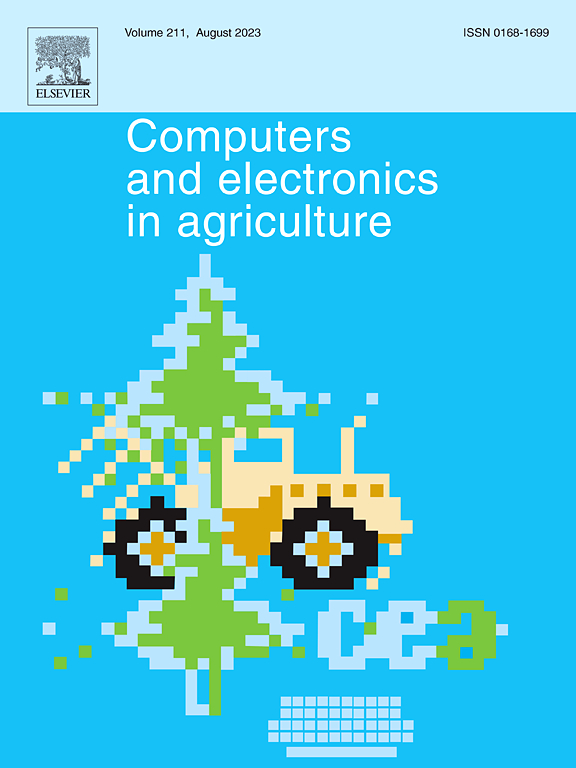果园植保作业中多台无人地面车辆路径规划与调度
IF 8.9
1区 农林科学
Q1 AGRICULTURE, MULTIDISCIPLINARY
引用次数: 0
摘要
提出了一种多农药、多载药基地果园多无人机施药路径规划与调度算法。基于现代果园的结构化作业环境,建立了UGV群的任务生成、行走喷洒路径生成和调度决策模型,优化了UGV群的能耗和运行效率。考虑多个UGV在作战场和补给基地之间的移动,建立了延迟时间计算模型,确定了UGV群的总作战时间。为了缓解群体供给延迟,减小ugv之间的运行结束时间差,提出了一种基于粒子群算法的ugv初始分配优化策略。试验结果表明,UGV群效率受UGV数量、载药量和果园病虫害防治供药时间的影响较大。增加用于果园作业的ugv数量直接减少了总作业时间,特别是当ugv数量从1辆增加到3辆时。通过减少作业任务的数量,扩大UGV的装载能力,减少了非喷涂行走能量的浪费。然而,部署低载重能力(且成本更低)的ugv可以达到与使用相同数量的高载重能力(且成本更高)的ugv相似的效率。仿真结果表明,该算法可以有效地缓解和减小ugv之间的暖供延迟和运行结束时间差异。与其他方法相比,使用该方法可减少总操作时间50 min(总计约200 min)。同时,在许多情况下,可以显著减少UGV群中非喷涂行走能量浪费。本文章由计算机程序翻译,如有差异,请以英文原文为准。
Path planning and scheduling of multiple unmanned Ground vehicles for orchard plant protection operations
We propose a path planning and scheduling algorithm for multiple Unmanned Ground Vehicles (UGVs) engaged in pesticide application in orchards with multiple pesticide and power loading bases. Based on the structured operational environment of modern orchards, we develop a decision-making model for task generation, walking and spraying path generation, and scheduling of the UGV swarm, optimizing energy consumption and operational efficiency. Considering the movement of multiple UGVs between operation fields and supply bases, we establish a latency time calculation model to determine the total operation time for the UGV swarm. To alleviate swarm supply delay and reduce the operation end time difference between UGVs, we develop a PSO-based optimization strategy for the initial assignment of UGVs to different supply bases. The test results show that UGV swarm efficiency is strongly influenced by the number of UGVs, pesticide loading capacity, and supply time for orchard pest and disease control. Increasing the number of UGVs for orchard operations directly reduces total operation time, particularly when the number of UGVs increases from 1 to 3. Expanding UGV loading capacity reduces non-spraying walking energy waste by decreasing the number of operation tasks. However, deploying UGVs with lower loading capacity (and lower cost) can achieve similar efficiency to using the same number of UGVs with higher loading capacity (and higher cost). It is verified that the warm supply delay and operation end time differences between UGVs can be alleviated and reduced, respectively, by using the proposed algorithm. Compared to other methods, the total operation time could be reduced by 50 min (approximately 200 min in total) using the proposed method. Simultaneously, significant reductions in non-spraying walking energy waste in the UGV swarm can be achieved in many cases.
求助全文
通过发布文献求助,成功后即可免费获取论文全文。
去求助
来源期刊

Computers and Electronics in Agriculture
工程技术-计算机:跨学科应用
CiteScore
15.30
自引率
14.50%
发文量
800
审稿时长
62 days
期刊介绍:
Computers and Electronics in Agriculture provides international coverage of advancements in computer hardware, software, electronic instrumentation, and control systems applied to agricultural challenges. Encompassing agronomy, horticulture, forestry, aquaculture, and animal farming, the journal publishes original papers, reviews, and applications notes. It explores the use of computers and electronics in plant or animal agricultural production, covering topics like agricultural soils, water, pests, controlled environments, and waste. The scope extends to on-farm post-harvest operations and relevant technologies, including artificial intelligence, sensors, machine vision, robotics, networking, and simulation modeling. Its companion journal, Smart Agricultural Technology, continues the focus on smart applications in production agriculture.
 求助内容:
求助内容: 应助结果提醒方式:
应助结果提醒方式:


